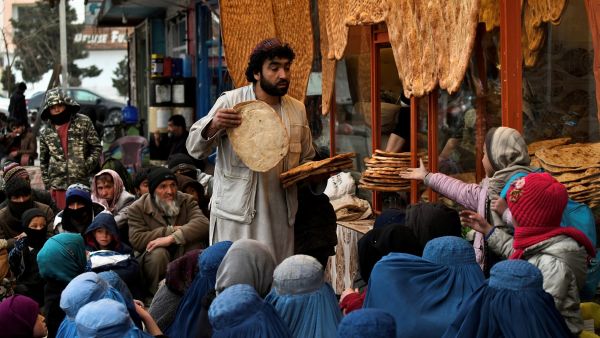By Farzad Ramezani Bonesh and Zahra Darbandsari
Although Afghanistan's economy was shattered by two decades of war, after the overthrow of the Taliban in 2001, the country's economy grew well, and turned to one of the highest growths in the region.
After 2012, due to increasing political and security problems, the country's economy experienced little growth, and in fact, in 2020, it faced more challenges with rising prices and food shortages. With the Taliban in power in August 2021, the scope of the economic collapse became very clear and widespread.
Major challenges of the country's economy
Afghanistan's economic collapse is a combination of factors and decisions taken such as drought, the loss of 40% of all crops, a sudden change of regime, the sudden cessation of foreign aid and international financial relations, the loss of human capacity, and so on.
Due to political instability and insecurity in Afghanistan, the Afghan economy became more unstable and the coronavirus epidemic and shocks resulted from that had a negative impact on the economy.
Afghanistan's economy is a consumer economy, dependent on imports of foreign goods and aid. Until August 2021, the Afghan National Budget, the Afghan Value (AFS) and the Afghan economy was heavily dependent on foreign aid. The massive drop in foreign aid, the US measure to block $9 billion from Afghanistan's Central Bank, and the Taliban's presence in power have had a negative impact on trade, industry, unemployment, GDP and investment.
In the last seven months, with the negative attitude of the United States, other governments and international institutions to the Central Bank of Afghanistan (to interact with the international banking system and international financial institutions) and the withdrawal of elites from the Central Bank of Afghanistan, the scope of challenges has increased.
In practice, foreign and international institutions do not recognize the credibility of the current banking authorities in Afghanistan. In fact, Afghanistan's banking sector (the engine of the economy) is in crisis and under the influence of the political environment and weak leadership. The country's currency is depreciating sharply and Afghanistan's crumbling banking system is out of the global financial system.
The challenges of Afghanistan's private banks continue, and without an efficient banking system, humanitarian activities have become extremely difficult. In fact, despite several "licenses" for humanitarian activities and dealings with Afghan government agencies and the World Bank's decision to deliver some of the suspended funds, sending foreign currency to Afghanistan, and to deposit in independent private banks, is difficult.
Although the Taliban are trying to take control of Afghanistan's economy, but the arbitrary actions Taliban officials and their direct and indirect approaches have exacerbated Afghanistan's dire economic situation.
From this point of view, the Islamic Emirate intends to lead Afghanistan to full self-sufficiency and to lift the remnants of Afghan sanctions. In practice, however, the Taliban do not accept "economic principles" and international standards, and approaches such as barring women from most jobs have had a devastating effect on families.
According to a World Food Program survey in February 2022, nearly 100 percent of female-headed households suffer from inadequate food intake. In addition, the country is experiencing a deep and deadly humanitarian crisis. Acute malnutrition is on the rise across the country.
95% of households face inadequate food consumption and food insecurity, and at least 55% of the population will be at emergency levels of food insecurity by March 2022.In fact, large sections of Afghan families have lost their wages.
As humanitarian aid organizations have repeatedly warned, the amount of aid is not enough to feed the entire population of the country. In this regard, UNICEF predicts that more than one million Afghan children need treatment for malnutrition.
In addition, the war and insecurity in Afghanistan in 2020 displaced about 400,000 people and made them homeless, but in the last year, due to the presence of the Taliban in Kabul and their political and security approach to the opposition, many Afghan people migrated to other countries, and the IDPs also increased.
Although initiatives such as responding to the 2022 Afghan Internally Displaced Persons and Afghan Refugees in five neighboring countries have somewhat reduced the scope of the crisis, the widespread influx of refugees and internally displaced persons has had a devastating effect on the country's economy and food situation.
In fact, factors such as drought and the effects of war have contributed to the country's humanitarian crisis, but economic shocks have exacerbated the situation.
Increasing food insecurity is directly related to income levels and income shortages. While Afghanistan's countryside is in crisis, with urban and poor middle-class households on the brink of collapse, Afghanistan's economy may shrink by about 20 to 30 percent a year.
In this context, the establishment of strong mechanisms for monitoring human rights, the extension of the mission of UNAMA in Afghanistan, the UN Security Council resolution for a broad exemption from sanctions, more oversight of the aid process, injecting more cash into the Afghanistan's economy, using reserves for specific purposes without considering the Taliban, etc. can be useful.
But it should be noted that fears of Taliban’s exploitation should not cause the country to face an exacerbated economic crisis. Indeed, although the UN Secretary-General is concerned about the situation in Afghanistan, the UN Security Council Resolution 2615 (December 22, 2021), and the World Bank's $ 280 million assistance to the World Food Program (WFP) and UNICEF can reduce the scale of the crisis in Afghanistan. But according to the UN envoy, famine may have been averted, but Afghanistan's economic crisis is deepening.
Vision
What is clear is that despite the major opportunities for relatively good capacity in the production, export and development of mines, poppy cultivation and drug trafficking have increased by 45% in Afghanistan compared to the same period last year. Afghans' per capita GDP is also consistently at the bottom of the international rankings.
At the same time, there is no international consensus on identifying the Taliban, and there are understandable concerns about the diversion of aid to consolidate power, and bypassing some of the international’s controls by the Taliban.
Meanwhile, if insecurity, the narcotics economy, lack of human capital, organizational weakness, corruption, geostrategic rivalry between foreign actors continue, Afghanistan's huge humanitarian and food crisis and predictions of further weakness or a one-third reduction in Afghanistan's economy will occur this year.
This is while the crisis in Ukraine has increased the prices of oil, gas, flour and wheat needed by Afghanistan, and the attention of the United Nations and the international community may gradually shift from Afghanistan to Ukraine.
At the same time, an international conference to raise funds for Afghanistan is not enough to prevent famine and the consequences of a civil war. In fact, the outlook of Afghanistan's economy depends on security and political stability inside the country, and a kind of coordination of actors and international and regional institutions to secure and take steps to form an inclusive government.









